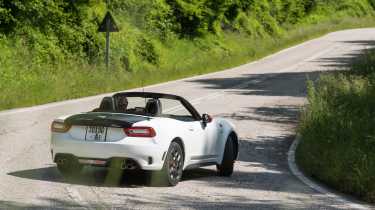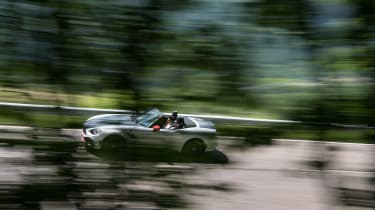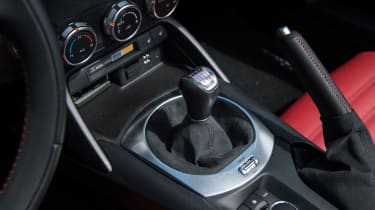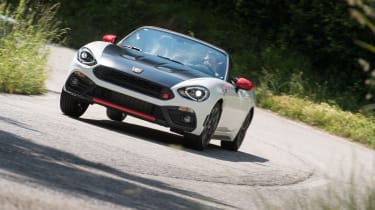Abarth 124 Spider review – A lot of fun, but not without its faults
170bhp, just over a ton, rear-wheel drive and an LSD; the 124 Spider has the basis of a great sports car. But it isn’t perfect
This is the Abarth 124 Spider. It’s based on the Fiat 124, and to create it Abarth has taken the same approach as it did to turn the Fiat 500 into the Abarth 595. That’s to say more power, a more focused chassis, more aggressive looks and, quite significantly, more noise.
The 124 Spider, as you probably know, shares the same platform as the Mazda MX-5 and the Fiat 124. But where Fiat’s version transforms the shared format into a more comfortable cruiser, the Abarth is more extreme and the most performance orientated of the three.
Engine, transmission and 0-60 time
The Abarth uses the same 1.4-litre, four-cylinder turbocharged engine as the Fiat 124, except in the Abarth it makes 170bhp – 32bhp more than in the Fiat. However, torque only rises by 7lb ft to 184lb ft.
The engine revs with the spritely verve you’d expect of an Italian sports car. Below 3000rpm, and off boost, it does feel a bit lethargic, but for the last half of its rev range, up to the engine’s 6500rpm limit, it makes the 124 feel exciting and energetic. There’s no doubt it feels turbocharged, but the slightly irregular delivery is far from unpredictable. Throttle response is also good, and the fast-revving engine makes heel-and-toe downchanges easy and entertaining.
More reviews
The Abarth covers 0-62mph in 6.8sec – a pretty respectable figure for a sub-200bhp car. For comparison, the 158bhp, 2-litre MX-5, which weighs 60kg less at 1000kg, manages the dash to 62mph in 7.3sec.
What’s most significant about the engine, more so than the power or the delivery, is the noise it makes. If you’re used to the big, burbling noise emitted from the little 500-based Abarths, then the 124 will sound familiar. The brazen, unapologetically loud noise emitted from its quad exhausts lets you know the Abarth is more aggressive than an MX-5, but also that it shouldn’t be taken too seriously.
The gearchange is surprisingly heavy. This is accentuated by the dumpy lever and short throw, but it’s incredibly satisfying to use. It feels slightly like you have to manhandle it, but you can make quick, precise yet aggressive changes.
Technical highlights?
As with the Fiat 124 Spider and the Mazda MX-5, everything is blissfully simple. But what the Abarth gets over the Fiat and some variations of the Mazda is a limited-slip differential. An LSD in a small, lightweight, rear-wheel-drive sports car is a recipe for fun.
As well as the diff, the Abarth – unlike the other two – has a Sport switch. Putting the 124 into Sport makes the throttle feel more immediate, adds some weight to the steering and slackens off the ESP and traction control.
What’s it like to drive?
The first thing you notice as you drive down the road is that the structure of the Abarth feels taught and more rigid than the Fiat or Mazda’s. The Abarth gets a strut brace to try to strengthen the body and stop the constant resonance that pulsates through its two relations. It works to an extent, but the body still doesn’t feel as solid as some of the best modern soft-tops.
The suspension may well be to Abarth’s own specification, but the way the car drives isn’t dissimilar to an MX-5. There’s still plenty of movement in the body. These exaggerated movements do make it feel like you’re really working the car, and you can use relatively soft touches to the brakes and the power to shift the weight to the front or rear of the car.
Push harder and the body roll and pitch become frustrating. Heavier braking and harder acceleration create a more dramatic change in grip across the axles. The body also seems to take a while to regain its composure out of corners and feels deeply confused in quick direction changes. Get on the throttle too hard and too early in a corner and, as the front rises, the Abarth wants to push into understeer.
Or at least you think so, because it’s hard to tell. The front end always feels vague, the steering never transmitting any relevant feedback to your hands. If front-end grip was exceptional, there’d be little to worry about. If you could rely on the car to exactly follow where you pointed the front wheels, you’d develop confidence in the grip at the front. But carry too much speed into a corner, which is easily done thanks to the poor feel, and it certainly does understeer. If the road is partly wet and the grip isn’t constant, it’s impossible to gauge.
But it’s certainly not all bad. If the 124 does understeer then it will transition easily and progressively into oversteer. With the traction control off there’s enough grunt from the engine to overwhelm the rear tyres and induce oversteer without throwing the car into a corner. This means you can have plenty of fun without having to delve too deep to find colossal amounts of commitment that would be completely inappropriate for the road.
The Abarth feels most comfortable driven on the throttle, the back-end squatting over the rear wheels and each movement of the accelerator working the LSD, changing the 124’s angle of attack. Keep it within the available grip of the tyres and it’s still effective and fun. Break traction and the Abarth continues to behave predictably. Reading the rear-end is very easy, partly due to the limited slip diff. And on an unknown road, the Abarth is a very fun, predictable and dependable companion. Just don’t ask too much of the front tyres.
Price and rivals
The Abarth 124 Spider costs £29,850, which is far from an insignificant amount of money. That’s £5555 more than the top-spec Sport Recaro MX-5.
However, despite being turbocharged and heavier, the Abarth is still more fun to drive. £5555 more fun? Possibly not. Although consider that the Abarth will be more rare, is marginally more luxurious, and that its badge has some substantial heritage and you can start to justify the extra price.
A BMW Z4 sDrive18i is a similar price to the Abarth at £ 29,695, but it’s down on horsepower, weighs a lot more and doesn’t have a limited-slip differential, and that all contributes to a far less fun package.
If it’s rear-wheel-drive excitement you want, both the Toyota GT86 and the Nissan 370Z do a better job than the Abarth. They’re sharper and more focused than the soft-top 124and therefore more rewarding to drive.






